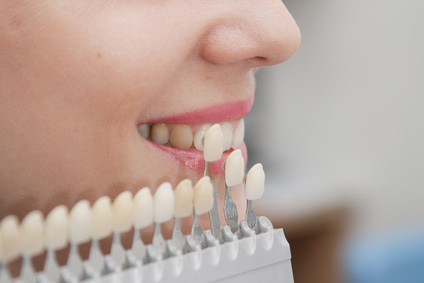Dental Veneers
Artistry in DentistryWhat are dental veneers?
 Dental veneers are small custom designed and manufactured pieces of a resin material, ceramic or porcelain that a dentist bonds to your teeth. I will discuss with you about which of the materials is best for you.
Dental veneers are small custom designed and manufactured pieces of a resin material, ceramic or porcelain that a dentist bonds to your teeth. I will discuss with you about which of the materials is best for you.
The first step is not to begin grinding on the teeth but rather to determine the ideal outcome. Impressions are taken of your mouth to create study models. These models are used for diagnostic evaluation and for the planning of your case. A diagnostic wax-up is prepared from your models to create a proposed ideal smile. This can be copied with a stent and is transferred to your mouth as a provisional restoration. During this stage the patient and the doctor can evaluate the new look. Patients can get input from friends and family if they desire. Often, patients are blown away by the exquisite new look of the provisional even before the final restoration is delivered. Careful evaluation utilizing the diagnostic wax-up is essential in determining how much tooth needs to be removed.
Do I have TMJ Disorder?
Symptoms include migraines, neck pain, jaw pain, lower back pain, snoring, sleep apnea. Use our Free TMJ Disorder Assessment ToolsDental veneers are only as good as the artistry of the doctor and the laboratory. When the best veneers are done people see the beautiful smile as totally integrated with the face. It is not just white teeth that most patients want but rather vibrant smiles that add to their appearance. They want to look great not have people stare at their teeth. Exceptional smiles are the result of careful planning and close collaboration between dentists and their laboratories.
Prior to bonding a veneer on your tooth, your doctor will try in and evaluate your smile. The dentist will carefully etch – or scratch – the surface of the damaged tooth before applying a thin layer of cement and placing the veneer on the tooth. Bonding the material onto the surface keeps it from slipping and ensures that it fits comfortably in your mouth.
How do dental veneers help TMJ sufferers
Dentists often suggest a veneer if you have damaged or chipped teeth due to a bite problem. Restoring broken teeth can be integral to treating a TMJ disorder. When patients are having definitive correction of a jaw problem ceramic veneers and onlays can be used in a minimally invasive method. The use of veneers and inlays is an alternative to orthodontic procedures or crown and bridge.
Dental Veneers and restorative dentistry are only used to treat TMJ disorders and headaches as a long term alternative to an orthotic after successful treatment with a diagnostic orthotic.
Onlay veneers can be placed over the biting surfaces of the back teeth to permanently correct the bite and eliminating TMJ appliances. Physiologic dentistry and the use of a diagnostic orthotic lets the patient evaluate a new jaw position prior to dental work. The best time to address problems is before the crowns, veneers and inlays are prepared.
Dental Veneers will restore the natural bite that you had before the injury and limit any symptoms that you experience.
Ready for more information
 No two patients are exactly the same, which is why your dentist will talk to you about more than one treatment plan. There are some simple exercises that you can do to tighten and strengthen the muscles in your jaw and neck, which will take pressure off your joints, but you can also use braces and other orthodontic procedures to improve your bite.
No two patients are exactly the same, which is why your dentist will talk to you about more than one treatment plan. There are some simple exercises that you can do to tighten and strengthen the muscles in your jaw and neck, which will take pressure off your joints, but you can also use braces and other orthodontic procedures to improve your bite.
Dentists recommend anterior porcelain veneers as a TMJ treatment for those who have one or more broken, chipped, mishapened or discolored teeth. Veneers and onlays can restore your smile and your bite and reduce the damage that causes your TMJ symptoms
If you want to know more about the disorder and how veneers can improve your bite, download my TMJ e-book.


0 Comments